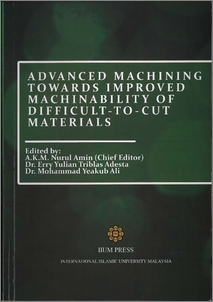Amin, A. K. M. Nurul and Mokhtar, Suhaily and Ab. Razak, Nur Hayati
(2011)
Machinability aspects in heat assisted machining of hardened steel AISI H13 using coated carbide tool.
In:
Advanced Machining Towards Improved Machinability of Difficult-to-Cut Materials.
IIUM Press, Kuala Lumpur, Malaysia, pp. 27-33.
ISBN 9789674181758
![[img]](http://irep.iium.edu.my/style/images/fileicons/application_pdf.png)  Preview |
|
PDF ( Machinability aspects in heat assisted machining of hardened steel AISI H13 using coated carbide tool)
- Published Version
Download (558kB)
| Preview
|
Abstract
AISI H13 tool steel is one of the major hardened materials used extensively for making hot
working moulds and dies, because of favourable combination of their mechanical and thermal
properties. However, these enhanced properties, especially high hardness make them very
difficult to machine using conventional techniques. In the current project a technique of
workpiece heat assisted machining was adopted as a possible means of improving machinability
of the material. Machining was conducted on a vertical machining centre using TiAlN coated
carbide inserts and heating of the workpiece was carried out using an induction heater. An online
vibration monitoring system was used to record the vibration signals during machining.
Comparison between room temperature and heat assisted machining was then made in terms of
tool wear and life, surface finish and chatter/vibration. It was found that tool life was higher
under heat assisted machining condition. Heat assisted machining also yielded lower surface
roughness and lower amplitudes of chatter during machining. AISI H13 tool steel is a widely
used material in mould and die making industry, because of its high hardness and ability to
sustain severe operating condition. The other properties that make H13, as an inevitable material
for mould and die are high resistance to deformation and breaking under high loads, high
hardness at elevated temperature and high wear resistant. However, these properties of H13 do
possess some of unfavourable effect in terms of machining process. For this, enhancement of
machinability of H13 tool steel drew the attention of many researchers and metal cutting
scientist. Despite the importance of end milling operation for the manufacturing of mould and
die, most of the research work concentrated mainly on the turning operation of H13 tool. In this
perspective, the current study adopted preheating as a technique to enhance machinability of
H13.
The industrial adoption of hard machining was made during the last decade with the
improvement of cutting tool material, coating technologies and advanced machining techniques.
Generally, hard machining involves the machining of material with a hardness value over 45 HRC. Hard machining has provides a significant cost or lead-time reduction in comparison to
traditional route processes. Moreover, adoption of hard machining technique has been the
requirement for further improved dimension tolerances in cutting operation. In addition to this,
hard machining provides the elimination of distortion due to heat treatment from the process of
traditional route processes. Zaima, Shigeo. Takeda, Hirohisa. Morishita, Sadamu (1974) reported
a number of advantages of hot machining of cast high silicon aluminum alloys.
It can produce comparable surface finish as in abrasive super finishing up to 0.4 μm in average
roughness value (CR. Liu and S. Mittal, 1995). This innovative process not only has great
potential to save significant cost, to increase production flexibility, and to reduce the pollution
due to dry cutting, but also yields parts with higher surface quality and longer service life (CR.
Liu and S. Mittal, 1996). Akira et al (2005) compared the performance of CBN and TiAlN coated
carbide-cutting tools in milling hardened carbon steel and recommended the TiAlN coated carbide
tool for low-speed hard milling. It was also observed that the hardness of workpiece had a great
influence on the cutting temperature.
In this context, the main objective of this work was to make a comparison on the effectiveness in
machining hardened steel AISI H13 under room temperature and preheated condition in terms of
tool life, surface finish and vibration and chatter amplitude.
Actions (login required)
 |
View Item |


 Download Statistics
Download Statistics Download Statistics
Download Statistics